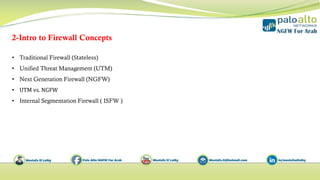01- intro to firewall concepts
- 1. 2-Intro to Firewall Concepts ? Traditional Firewall (Stateless) ? Unified Threat Management (UTM) ? Next Generation Firewall (NGFW) ? UTM vs. NGFW ? Internal Segmentation Firewall ( ISFW )
- 2. Traditional Firewall (Stateless) = Packet Filter Firewall A traditional firewall filters traffic based on mainly the following parameters : ? Source IP address and destination IP address of the network packets. ? Source port and destination port of the inbound and outbound traffic. ? Current stage of connection. ? Filtering rules based on per process basis. ? Protocols used. ? Routing features.
- 3. Traditional Firewall (F.W) Other common features of a traditional firewall include support ? Routing ? Network Address Translation (NAT) ? Port Address Translation (PAT) ? Virtual Private Network (VPN)
- 5. Why Legacy Firewalls Are No Longer Effective?
- 7. Classify traffic based on applications, not ports. Traditional firewalls can filter traffic based on port, but that may prove to be inconvenient at times. Layers 2 & 3 & 4 UTM can associate traffic based on application, which enables it to block or monitor network traffic per application and troubleshoot problems based on that. Layers 7
- 8. Managing Users and Use Policies
- 9. Stopping Malware, Intrusions and Advanced Attacks
- 10. Intrusion Detection System (IDS) Intrusion Prevention System (IPS)
- 16. Internal Segmentation Firewall ( ISFW )= Data Center Firewall

















